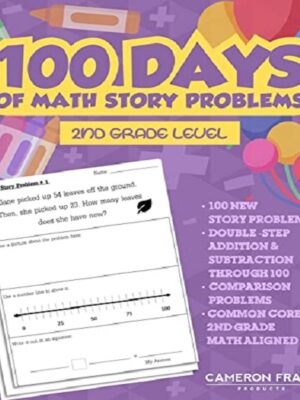Description
Math For Middle School: Proportional Reasoning & Scale Drawings Worksheets
Introduction
In middle school, mathematics plays a crucial role in shaping a student’s understanding of various concepts. One of the fundamental topics in math is proportional reasoning and scale drawings. These concepts form the basis of understanding how quantities are related to each other and how they can be represented accurately in drawings. In this article, we will explore the significance of proportional reasoning and scale drawings, their relevance in real-life scenarios, and how worksheets can aid students in mastering these concepts effectively.
Table of Contents
- What is Proportional Reasoning?
- Understanding Scale Drawings
- The Importance of Proportional Reasoning and Scale Drawings
- Real-Life Applications of Proportional Reasoning
- 4.1. Cooking and Recipes
- 4.2. Maps and Navigation
- 4.3. Architectural Designs
- 4.4. Creating Models
- Teaching Proportional Reasoning and Scale Drawings in Middle School
- 5.1. Engaging Activities
- 5.2. Interactive Lessons
- 5.3. Group Projects and Discussions
- Worksheets for Proportional Reasoning and Scale Drawings
- Designing Effective Worksheets
- 7.1. Clarity and Conciseness
- 7.2. Step-by-Step Approach
- 7.3. Variety of Problems
- 7.4. Real-Life Scenarios
- Using Technology for Practice
- Overcoming Challenges in Proportional Reasoning
- 9.1. Common Misconceptions
- 9.2. Addressing Individual Learning Needs
- 9.3. Building Confidence
- Tips for Teachers and Parents
- 10.1. Creating a Supportive Environment
- 10.2. Encouraging Critical Thinking
- 10.3. Celebrating Progress
- Conclusion
- FAQs
- 12.1. What is the difference between proportional reasoning and scaling?
- 12.2. Can I use proportional reasoning to solve real-world problems?
- 12.3. How can worksheets improve a student’s understanding of these concepts?
- 12.4. Are there any online resources for additional practice?
- 12.5. What are some fun activities to teach scale drawings to middle school students?
What is Proportional Reasoning?
Proportional reasoning is a mathematical skill that involves understanding the relationship between two or more quantities and how they change together. It helps students comprehend how changes in one variable affect the other in a predictable manner. The concept of proportionality is fundamental in various mathematical topics, including fractions, ratios, percentages, and algebra.
Understanding Scale Drawings
Scale drawings are representations of real objects or spaces in a reduced or enlarged size. They are used to provide an accurate visual representation of objects that may be too large or too small to draw at actual size. Scale drawings are commonly used in maps, architectural plans, engineering designs, and model-making.
The Importance of Proportional Reasoning and Scale Drawings
Proportional reasoning and scale drawings are essential skills that have practical applications in everyday life. Understanding these concepts allows individuals to make informed decisions, solve problems efficiently, and interpret information accurately. Whether it’s adjusting a recipe’s ingredients, reading maps, or creating scale models, proportional reasoning and scale drawings are invaluable skills.
Real-Life Applications of Proportional Reasoning
4.1. Cooking and Recipes
Proportional reasoning is crucial in the culinary world, where precise measurements are essential for successful recipes. Adjusting the quantities of ingredients while maintaining the right proportions is vital to achieve the desired taste and texture of dishes.
4.2. Maps and Navigation
Scale drawings play a vital role in maps, allowing individuals to understand distances and locations accurately. Whether planning a road trip or navigating through unfamiliar terrain, scale drawings help us make informed decisions.
4.3. Architectural Designs
Architects use scale drawings to design buildings and structures effectively. These drawings provide a visual representation of the final product and aid in making adjustments before construction begins.
4.4. Creating Models
Proportional reasoning is used when creating models for various purposes, such as in the fields of engineering, product design, and art. Scale models allow designers to visualize and test ideas before producing the final product.
Teaching Proportional Reasoning and Scale Drawings in Middle School
Engaging middle school students in learning proportional reasoning and scale drawings is essential for their overall mathematical development. Here are some effective teaching approaches:
5.1. Engaging Activities
Incorporate hands-on activities and real-life scenarios to make learning interactive and enjoyable. Students can work in groups to solve problems and create scale models of familiar objects.
5.2. Interactive Lessons
Use multimedia tools and interactive software to present complex concepts visually. Visual aids and interactive lessons can enhance students’ understanding and retention of the material.
5.3. Group Projects and Discussions
Energize a bunch of undertakings and conversations to advance cooperative learning. This approach permits understudies to gain from one another and fabricate critical thinking abilities together.
Worksheets for Proportional Reasoning and Scale Drawings
Worksheets are important apparatuses for supporting learning outside the study hall. All-around planned worksheets offer understudies the chance to rehearse their abilities autonomously and at their own speed.
Designing Effective Worksheets
When creating worksheets for proportional reasoning and scale drawings, consider the following factors:
7.1. Clarity and Conciseness
Ensure that instructions and questions are clear and easy to understand. Avoid unnecessary complexities that might confuse students.
7.2. Step-by-Step Approach
Present problems in a step-by-step manner to help students grasp the concepts gradually.
7.3. Variety of Problems
Include a diverse range of problems that cover different scenarios. This will challenge students and reinforce their understanding of proportional reasoning and scale drawings.
7.4. Real-Life Scenarios
Incorporate real-life examples to demonstrate the practical applications of these concepts.
Using Technology for Practice
Leverage technology to provide students with additional practice opportunities. There are numerous online resources, interactive games, and apps that offer engaging practice exercises.
Overcoming Challenges in Proportional Reasoning
Some students may find proportional reasoning and scale drawings challenging. As educators and parents, it is crucial to address these challenges effectively:
9.1. Common Misconceptions
Identify common misconceptions and provide targeted support to correct them.
9.2. Addressing Individual Learning Needs
Recognize that each student learns differently and adapt teaching strategies to cater to individual needs.
9.3. Building Confidence
Encourage and praise students for their efforts, building their confidence in tackling mathematical problems.
Tips for Teachers and Parents
Supporting students in their learning journey is vital. Here are some tips for both teachers and parents:
10.1. Creating a Supportive Environment
Establish a positive and supportive learning environment where students feel comfortable asking questions and seeking help.
10.2. Encouraging Critical Thinking
Advance decisive reasoning and critical thinking abilities by introducing inquiries without a right or wrong answer and testing situations.
10.3. Celebrating Progress
Acknowledge and celebrate students’ progress and achievements, motivating them to continue improving.
Conclusion
Proportional reasoning and scale drawings are foundational mathematical concepts that empower students to navigate real-life situations with confidence. By mastering these skills, students can make informed decisions and understand the world around them more accurately. With the support of engaging worksheets, interactive lessons, and supportive teachers and parents, students can build a strong mathematical foundation that will benefit them throughout their lives.
FAQs
12.1. What is the difference between proportional reasoning and scaling?
Proportional reasoning involves understanding the relationship between quantities, while scaling refers to representing objects or spaces in a reduced or enlarged size.
12.2. Can I use proportional reasoning to solve real-world problems?
Absolutely! Proportional reasoning is applicable in various real-life scenarios, from adjusting recipes to interpreting maps and architectural plans.
12.3. How can worksheets improve a student’s understanding of these concepts?
Worksheets provide valuable practice opportunities that reinforce learning and help students develop their skills independently.
12.4. Are there any online resources for additional practice?
Yes, there are numerous online resources, interactive games, and apps that offer additional practice exercises for proportional reasoning and scale drawings.
12.5. What are some fun activities to teach scale drawings to middle school students?
Engaging students in creating scale models of familiar objects or designing their dream houses can make learning scale drawings enjoyable and practical.
Get Access Now: This Link
Website Developer Link














Reviews
There are no reviews yet.